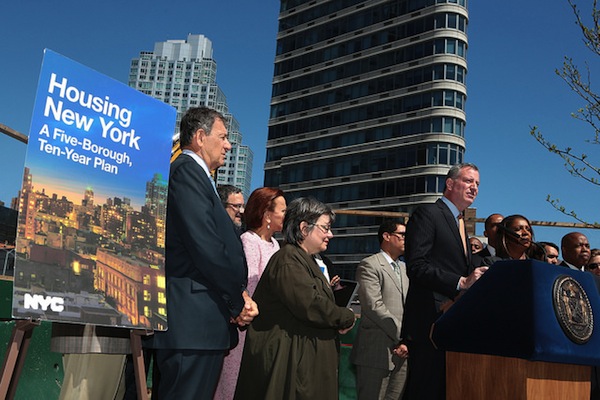
Photo by: Rob Bennett for the Office of Mayor Bill de Blasio
De Blasio’s plan left many details to be worked out by city agencies.
If the statements piling up in reporter’s inboxes Monday afternoon were any indication, response to Mayor de Blasio’s 10-year, 200,000-unit, $41 billion affordable housing plan was overwhelmingly positive.
City Hall put out a 7,100-word press release cataloguing praise from a federal Cabinet secretary, a Catholic cardinal, a United States senator, seven members of Congress, the public advocate, state attorney general, city comptroller, Assembly speaker and six members, all three state Senate caucus leaders and four other members, a borough president, the speaker and 20 members of the City Council and an assortment of leaders from advocacy groups and unions.
But a few cautious notes were sounded.
The Association of Neighborhood Housing Developers heaped praise on the plan, but noted that the proof will be in implementation, noting that the affordability of “affordable housing”—which is sometimes pegged to income levels that bear no relation to reality in the city—and the issue of permanence remain concerns.
“Affordable housing that will best meet the needs of local communities and build stronger neighborhoods means building housing that is truly affordable to local residents, building housing that will be affordable for generations to come, not just 30 years, and preserving affordable housing and diverse, mixed-income communities in places where rents are skyrocketing and long-term residents are being rapidly pushed out,” read their statement.
Councilman Jumaane Williams of Brooklyn also cheered the plan. But Williams called for more detail on plans for NYCHA, and wanted to hear more about repealing the Urstadt Law that gives Albany control of the city’s rent stabilization rules.
The de Blasio administration said little about the way they’d handle mixed-income developments, saying those details would be worked out site by site, but expressed interest in a 50/30/20 model that targets 50 percent of units to middle-income families, 30 percent to moderate-income applicants and 20 percent to low-income households. Williams is interested in models that direct more units to the poor.
So is the Community Service Society (City Limits’ parent organization), which lauded the plan as “comprehensive” and “impressive” but added: “We urge the mayor and his team in the coming months to find ways to deepen the income targeting proposed in the plan, particularly for newly developed apartments. Under the de Blasio plan only 20 percent of the units would be accessible to New York families with the lowest incomes, up to $38,000 for a family of three, but families at that income level make up 73 percent of those paying more than 30 percent of their income for rent.








